Pacific Electric Redlands Local Lines
Pacific Electric Arrowhead Line
Pacific Electric San Bernardino Local Lines
Pacific Electric San Bernardino-Redlands Line
Redlands Area Historical Society
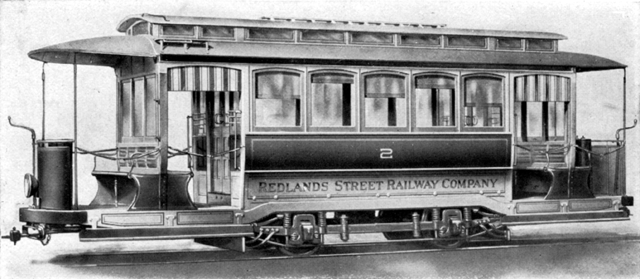
| Length of Body | Length over Dashers | Approximate Weight of Car | Type of Truck |
| 13' 5½" | 29' | 8,500 lbs. | Brill No. 21-E |

|
Smiley Heights Line Route: From Orange & Citrus, south on Cajon to Cypress Avenue, west on Cypress to Cedar Street, west on Cedar to Canyon Crest Park, Smiley Heights. History: Built 1899 by Redlands Street Railway to Smiley Heights, with car No. 1 making first run on 19 December 1899. In 1900, extended to Terracina, opening on 6 November 1900. Sold to Henry Huntington in 1908. Sold to Pacific Electric in 1911. Latter connection to Terracina removed 1920 (See Olive Avenue Line). Last Pacific Electric car to Smiley Heights ran on 20 July 1936. |
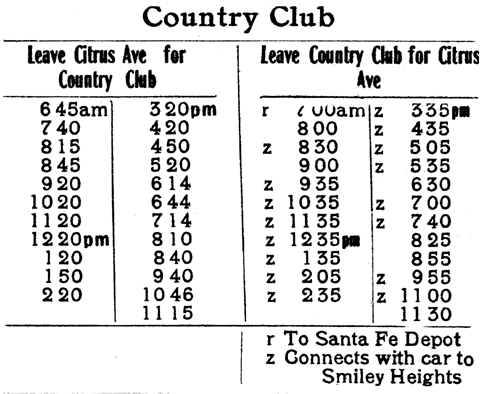
|
Country Club Line Route: From Orange & Citrus, south on Cajon Street to Country Club. 2.81 miles, all single-track; 1.42 m. on private way, 1.40 m. in city streets. History: Built by Redlands Street Railway in 1889 and 1901. Abandoned by Pacific Electric 23 May 1926, and rails removed at once beyond Cajon & Cypress. |
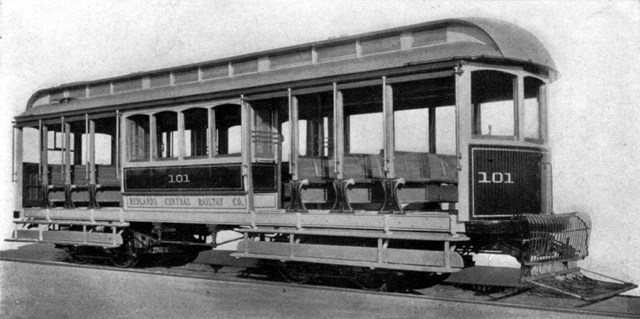
| Length of Body | Length over Dashers | Approximate Weight of Car | Type of Truck |
| 10' 2½" | 37' 1¼" | 10,800 lbs. | Brill No. 27-G1 |
Purchased the lines of the Redlands Street Railway, June, 1903
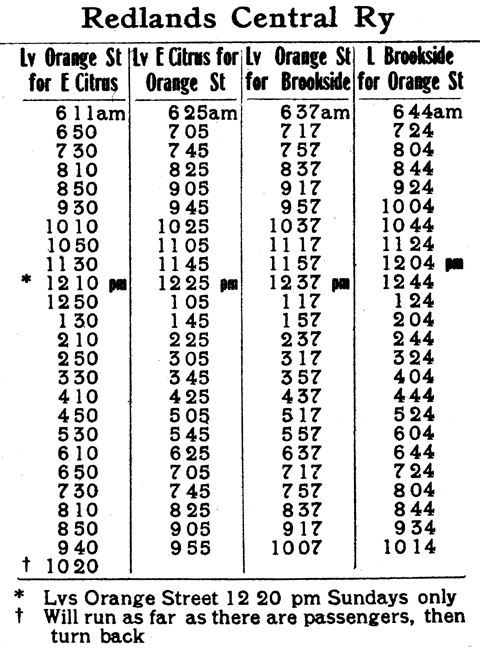
|
Brookside Line Route: From Orange & Citrus, west on Brookside Avenue to San Mateo. History: Built in 1908 by Redlands Central as extension of its Citrus Avenue Line; was intended to go through to Riverside, but sale of Redlands Central stopped all extensions. Sold to Henry Huntington in 1908. Sold to Pacific Electric in 1911. Abandoned by Pacific Electric 16 June 1926.
Citrus Avenue Line
|
San Bernardino Valley Traction Company 1903-1911
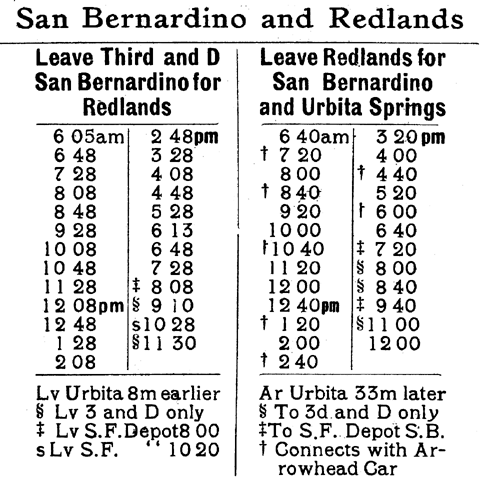
|
San Bernardino-Redlands Line Route: From 3rd and D, San Bernardino, via Third to "A" Street, then via private way crossing Second, Mill Street, Tippecanoe, La Quinta, Crown Jewel to San Bernardino Avenue, thence east on San Bernardino Avenue to Orange Street, and south on Orange Street to Citrus Avenue. History: Built by SBVT in 1902-1903 from city limits of Redlands to San Bernardino; opened on 3 March 1903. Cars operated into Redlands thru trackage right agreement with Redlands Street Railway. On 6 June 1903 these two companies merged. Huntington obtained control of SBVT on 10 June 1907 and it became part of the PE system on 1 September. 1911. 1913 saw line rebuilt with 90 lb. rail. |
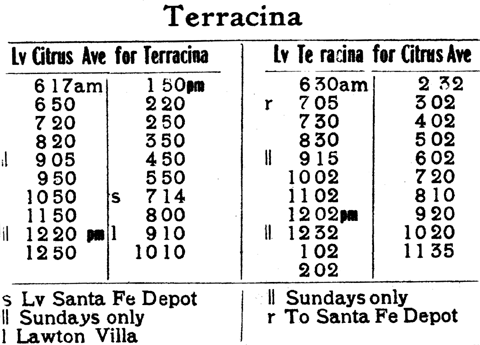
|
Olive Avenue Line Route: From Orange & Citrus, south on Cajon to Olive Avenue, thence west on Olive Avenue and Laurel Street to Terracina. Like all Redlands lines, it was single track. 2.03 miles long, all in city streets. History: Built 1903 by SBVT to Bellevue & Laurel; opened in November, 1903. Extended along Laurel St. to Terracina in 1904, opening to Terracina in September, 1904. In got the bulk of the Terracina traffic, being more direct than the Smiley Heights route. Abandoned by Pacific Electric 20 December 1922; rails removed in 1923. |
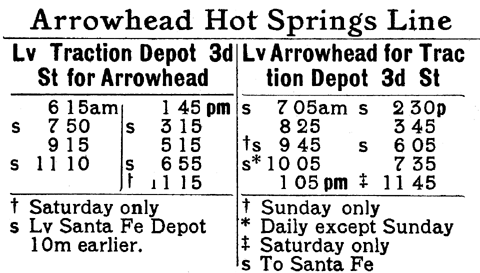
|
Arrowhead Hot Springs Line Route: Built from 3rd & D to Base Line & D by SBVT in 1901; it was the first electric line in San Bernardino and opened for service on 22 February 1902. Extension north to Arrowhead Springs Hotel was built 1906-1907 and opened on 15 March 1907. History: Final abandonment of passenger service took place on 1 September 1932. Freight service continuing on; composed entirely of tank cars to and from bottling works at Arrowhead Springs; this service was dieselized in 1943. Serviced today by trucks of the Arrowhead water company. |

|
Urbita Hot Springs Line Route: From 3rd & D west on 3rd to E St., south on E to Urbita Springs. History: Built by SBVT in 1902 and Urbita Springs amusement park was built in the year 1903. SBVT built its shops on this line. Abandoned by Pacific Electric 17 October 1927, track removed at once. (1.455 miles of single track on E Street) This line in summer time hauled fabulous crowds. Old timers recall conductors on open cars 38 and 39 (PE) turning in their transfers in bushel baskets full to overflowing. Special days at the Springs brought through service from Redlands and Colton, taxing the single track on E Street to absolute capacity. Meets were made at the car barn wye. Urbita Springs replaced Harlem Springs as "the" resort-amusement park of San Bernardino County. Among its attractions were swimming, dancing, picnic grounds, and boating. Pacific Electric sold this property in 1924 to Ernest C. Pickering, who opened it on 21 June 1924 as "Pickering Park." Until replaced by the 3rd Street Cut-Off in 1906, this line was part of the Redlands Line. |
MISCELLANY:
Local rail service in Redlands was evidently a losing proposition as far back as 1910:
"One wishes that the SBVT could furnish Redlands with better cars...It must be borne in mind, however, that the Redlands service does not pay the company...All things considered, Redlands enjoys excellent trolley service...."
From the Redlands "Review" for 15 January 1911.
Patrons of the Smiley Heights, Country Club and Olive Avenue lines got a pleasant surprise on June 30, 1911. With no advance announcement, the first red PE cars--114 and 115---appeared in Redlands and entered service at once; with them was a large SBVT car which also began running in Redlands local service. On July 1, 1911, the Redlands "Review" enthusiastically welcomed the "big" red cars: "PE cars in use here! To take the place of the dinky little cars that have been targets for much criticism! The three old timers that have been in used for many years (PE 80-82) have been relegated to the shed, where it is hoped they will be allowed to give up the ghost peacefully."
PE's car house in Redlands was located on E Citrus near Church Street. It was a rather large building and contained substation No. 26. This structure was erected by the Redlands Central and was that company's combined car house, substation and shops, with some office space as well. PE rebuilt the car house in 1922.
The Citrus Avenue Line served not only Sylvan Park and Redlands University, but at Church Street it passed the Redlands High School. The high school was built in 1910 and building material was delivered direct to the site via SBVT flat cars and a special spur track into the grounds.
An electric railway from Redlands into the Yucaipa Valley via Yucaipa, Oak Glen and Beaumont to San Jacinto was started in 1908; it completed a mile of track on Church Street, then "stopped for the winter." Paul Shoup (head of PE) traversed the proposed route in 1911 but evidently decided against the ambitious project for the time being. In September, 1917 PE again showed interest in building as far as Yucaipa and made a survey of the route in March 1918. In June of that year PE announced it would build to Yucaipa "as soon as possible." Then World War I and autos intervened.
Four Birneys of the 350 Class took over all local service in Redlands in 1918; from then until final abandonment in 1936, Redlands had nothing but these "cootie cars". The monotony was relieved, of course, by the big 1200s in through service to Los Angeles, the suburban cars (400s and 600s) to San Bernardino and Riverside, the periodic visits of the Orange Empire car, usually 1028, plus assorted box motors and electric locomotives.
The Triangle, formed in the heart of Redlands' business district by Orange and Cajon Streets and Citrus Avenue, was always the main transfer point. A shelter was erected in the tiny park for the comfort of waiting passengers.
SBVT contracted with the Salt Lake Line to handle that railroad's express matter(American Express Company) between Colton-San Bernardino and Redlands. Express packages were carried on regular cars and loaded and unloaded at the Triangle. By the end of 1911, so many complaints had been received that SBVT-PE was ordered to load and unload express at its car house, and to place a 1300 Class combo car on those runs which handled much express.